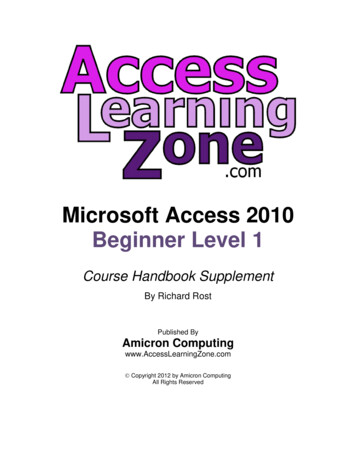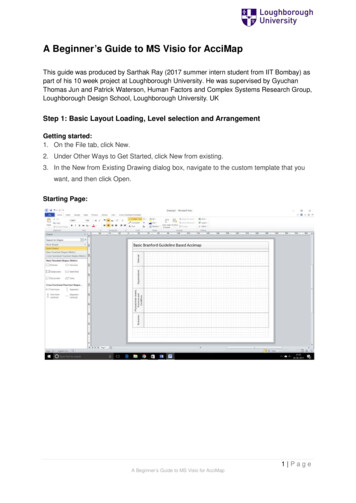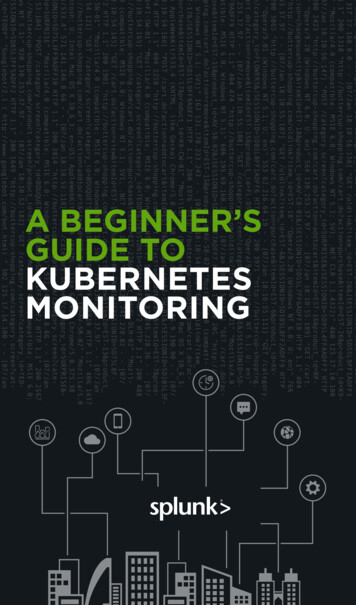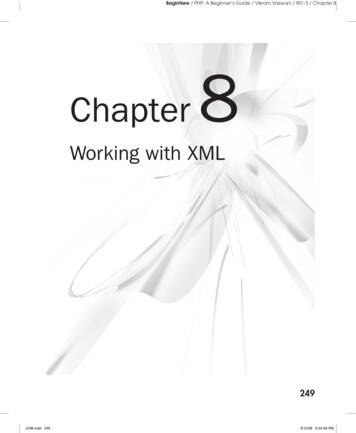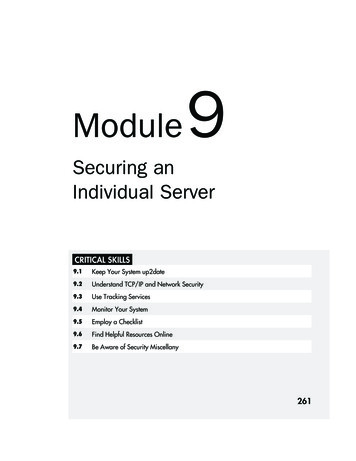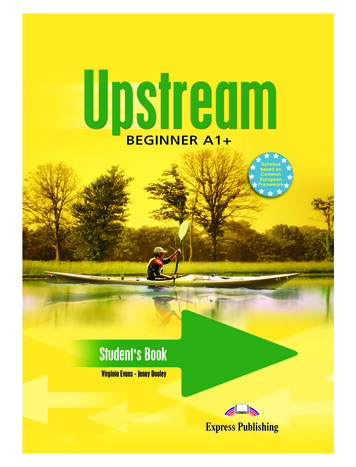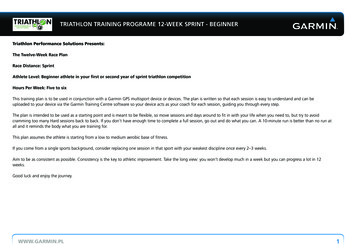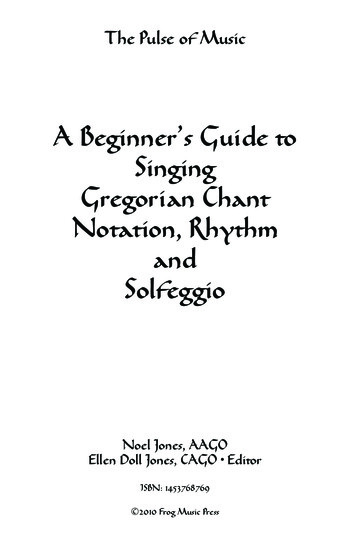
Transcription
The Pulse of MusicA Beginner’s Guide toSingingGregorian ChantNotation, RhythmandSolfeggioNoel Jones, AAGOEllen Doll Jones, CAGO EditorISBN: 1453768769 2010 Frog Music Press
SingingGregorian Chant NotationThe notes of chant,how they appear on the pageand what they mean.
Thislittle bookis dedicated tostaff andall the members ofThe Church Music AssociationofAmericafor all the good that they do.
Table Of ContentsChant Rhythm. 3Lengthened Chant Notes. 10Dot.16Horizontal Episema.20Counting In Chant.25Quilisma.29Salicus.33Counting. 36Instant Chironomy. 40Punctum Mora.42Learning Chant.45Chant Samples. 493. -72Solfeggio.67Punctum. 71Staff.73Clef.80Leaps.87Singing Chant Melodies.92Clivis. 93Virga.95Punctum Inclinatum. ilisma. 109Flat.111Decorations.113Measure Divisions. 115Liquescent. 116Custos.120
1The Musica Sacra website at www.musicasacra.com has a longlist of chant book resources that may be downloaded on theinternet. They also are publishing and reprinting books on thesubject. Their “An Idiot’s Guide to Square Notes” by ArleneOost-Zinner and Jeffrey Tucker is not to be missed.This short book is an effort to quickly outline and explain thesimple system of writing and reading chant. Prior to organization of the writing of chant into this form there were squiggledsigns above words that were the first attempts to preserve theoral tradition of sung chant.We hope that this book serves to answer questions, give you confidence and encourages you to study further the music of theChurch.
2A Brief Overview of Chant Notation The foundation of modern written music notation Easier to read than modern notation Takes less space on the page than modern notation. Chant is made up of small groupings of organized notes Each group has a different and consistent purpose Music staff covers just the range of the human voice There are only four lines in the staff Notes are always directly above the vowel that is sung There are only two clef signs There is only one sign, a flat. that alters the pitch of a note All chant may be written with the same note, a neume Neume groupings organize notes over their word syllables
SingingGregorian Chant Rhythm 4p. 5pH 3p4q5p 2p 4i35P All notes in chant are sung in the same flowing motion.We explore the four ways in which the flow is temporarilysuspended and the way this is notated in the music.
4I’m before the dot,before the quilisma,above the vertical episema in a salicus,above or below the horizontal episema,and anywhere at the director’s discretion.Who am I?I’m the “Note That May Be Lengthened.
5Chant RhythmChant was passed down by word of mouth. All notes are sung atthe same even speed until the director of the schola indicates anote that is to be held for a longer length than a normal note.For centuries there was no clear way to indicate these holds These heldnotes are what constitute the rhythm of chant.These are moments of suspension of time.The practice of marking notes on a staff of four lines has long been thestandard. in chant This tells what pitches to sing, but not how long tohold the notes that are commonly stretched.Different systems were tried, but none caught on. Some were vague,some were so exact that they caused chant to be sung in a metric, unnatural manner.It is not clear why a simple system was not adopted. There is conjecturethat this was a way of withholding information, as a form of job security. Only people in the know were able to lead the chants and indicatewhich notes were lengthened.The monks of Solesmes came up with a system that some feel is overlyrestrictive. Recently some are shifting to thinking that this was not amove to restrict the performance of chant but instead to free up the holdothers had on chant, and to make singing of it accesible.
pppppp6RhythmNotes in chant are not allsung one after the otherlike a clock ticking.
77d p 0p 4p 4p 5p 5p 4p 3p 3p 2p 2p 1p 1p p Chant was memorized and passed down from one generationto the next, totally unwritten for many years. Then churchfathers decided it was time to get it on vellum and eventually, on paper.Chant notation shows only the order of the pitches to besung.The above is a very familiar folk song.By looking at these notes, someone who had never heard thissong would All in a row, like a clock ticking.
87d p 0p 4p 4p 5p 5p 4p Twinkle, twinkle, little star7d 3p 3p 2p 2p 1p 1p p how I wonder what you are.Sing this.
97d p 0p 4p 4p 5p 5p 4p Twinkle, twinkle, little star7d 3p 3p 2p 2p 1p 1p p how I wonder what you are.We can tell you exactly how you have sung this.Without hearing you sing it.
107d p 0p 4p 4p 5p 5p 4p Twinkle, twinkle, little star7d 3p 3p 2p 2p 1p 1p p how I wonder what you are.You stretched two notes, held them longer than other notes.That’s rhythm.Why did you sing it that way? Because that’s the tradition.Gregorian Chant has its own traditions of held notes, but until the early 1900’s, there was no general agreement on howto show this on paper.
117d p 0p 4p 4p 5p 5p 4p Twinkle, twinkle, little star7d 3p 3p 2p 2p 1p 1p p how I wonder what you areGregorian Chant was the first written music.In chant, all notes are sung without pause, to a regular pacelike drops of water.But some notes are stretched out, lengthened. There arenow four common ways to show this.
12Lengthened chant notes. 4p. 5pH 3p4q5p 4i 2p35P
13Dot7d p 0p 4p 4p 5p 5p 4p Twinkle, twinkle, little star7d 3p 3p 2p 2p 1p 1p p how I wonder what you are.How can we indicate which note is to be lengthened?Scribing two notes close together?7d p 0p 4p 4p 5p 5p 4p’4p Twinkle, twinkle, little star7d 3p 3p 2p 2p 1p 1p 0p’p how I wonder what you are.This does not work, as the practice when singing chant is topulse repeated notes on the same syllable. Here you wouldget: “ah-ahr.”
14Dot7d p 0p 4p 4p 5p 5p 4p Twinkle, twinkle, little star7d 3p 3p 2p 2p 1p 1p p how I wonder what you are.Note that there is a period at the end of the above sentence.
15Dot7d p 0p 4p 4p 5p 5p 4p Twinkle, twinkle, little star7d 3p 3p 2p 2p 1p 1p p. how I wonder what you are.Let’s put a period after the last note.Hold that note twice as long as a normal note.
16Dot7d p 0p 4p 4p 5p 5p 4p. Twinkle, twinkle, little star7d 3p 3p 2p 2p 1p 1p p. how I wonder what you are.And let’s add a period, or dot, at the end of the first line,where singers always hold the note when singing this folktune.Hold the note exactly the length of two regular notes.
17Dot7d p 0p 4p 4p 5p 5p 4p. Twinkle, twinkle, little star7d 3p 3p 2p 2p 1p 1p p. how I wonder what you are.This is one of the simple ways that the rhythms, the lengthening of a note or groups of notes, are communicated whenwriting chant music.The dot doubles the length of a note.The length of the other three “hold” signs is determined bythe director.
18Dot7d 4p. Dot doubles the length of the note which precedes it.
19Dot7d p 0p 4p 4p 5p 5p 4p. Twinkle, twinkle, little star7d 3p 3p 2p 2p 1p 1p p. how I wonder what you are.Signs that alter the length of a note in chant are always inthe same place in relation to the note it affects.The dot is always after the note that is affects.
.5d 15P 4p- 13x3p13x1p 2p 3p -2p 1p. .5d 56P 5p 4p46x6p5p-5p 3p 1p 2p 2p. .7d 1p 2p 3p 4p 1p -3p 2p 2p. .5f 3p- 5p- 5p 35x5p4p 3p ’ -45P 4p 3L2l 3p 4p 3p. 20SamplesKy- ri- e, e- le- i- sonde ma-nupecca-toris.fu- it vol-un-tas e- o-rum.Be- a- tiom- nes, * qui ti- ment Dominum.It is a good to mark, above the staff, all notes that are to belengthened.
21Dot- - 4p. Some chant music will show a dot after the last note, somewill not. Most last notes will be lengthened, dot or not.A bit of history:It is universally understood that the last note of a chantshould be lengthened.But French monks, in their versions of chant books, decidedto use the dot to indicate a lengthening of the last note, andany other note that is traditionally lengthened in singing.The dot designating the “hold” was created.
22Horizontal Episema7d 5pH 7d 5ph orHorizontal Episema lengthens the note below or above it.
23Horizontal Episema - Expressive Time Alterations7d p 0p 4p 4p 5pH 5p 4p. Twinkle, twinkle, little star,Playing for opera singers is tough work because opera singershold some notes out longer than they are written.They do this to emphaze the word they are singing or thebeauty of the note.Chant is also sung this way.Sing the line above and hold “lit” as long as you like.It is entirely up to the singer when chanting alone, and to thedirector when a group is singing, how long this note will beheld and sung.
24Horizontal Episema - Expressive Time Alterations7d p 0p 4p 4p 5pH 5p 4p. Twinkle, twinkle, little star,How long this note will be held and sung?We do not know how long it will be held, but we can predicthow it might be sung.It’s an expressive device, so you can expect that that it willalso either:1. Get louder.2. Get Softer.3. Bloom the sound, later called a Messa di Voce.4. Stay the same - but this is not as common as 1 and 2.
25Horizontal Episema - Expressive Time Alterations7d p 0p 4p 4p 5pH 5p 4p. Twinkle, twinkle, little star,When a note marked with a horizontal episema is sung,time is suspended for a moment, as if a grandfather clocksuddenly hesitates in the middle of the night.This is a stretching of the length of the singing of the note.Often, cellists do this when playing chords under a melodynote, since it takes time to get across all the strings andthen play the melody note on the highest string.The next note immediately returns to the original tempo.All four signs that lengthen chant notes suspend time.
26Horizontal Episema - Expressive Time Alterations7d pH 0p 4ph 4p 5pH 5p 4p. Twinkle, twinkle, little star,Here the singer pauses on two notes. It is very common tofind Horizontal Episemas scattered throughout Chant scores.They affect only the note that they are placed above orbelow, as shown above.These held notes step out of time, giving chant much of itstimeless character.
27Counting in ChantModern musicModern music is built on repeated patterns that are consistent throughout a piece of music.12341234 123123123or4/4 and 3/4 time are the most common time signatures formodern music.ChantChant does not emphasis the first beat. And the pattern ofnotes is quite different.12121212312123Chant can, and will, alternate 1-2 and 1-2-3 note patterns.
28Counting in Chant7d pH 0p 4ph 4p 5pH 5p 4p. Twinkle, twinkle, little star,Chant is made up entirely of groups of two or three notes.7d pH 0p 4ph 4p 5pH 5p 4p. one two one two one two one twoYou will find that at some rehearsals you will sing the noteswith “one”, “two” and “three” instead of the words.How do you verbally count a lengthened note?
29Horizontal Episema - Expressive Time Alterations7d pH 0p 4ph 4p 5pH 5p 4p. one two o------ne two o-----ne two one twoWhen singing counted numbers for chant, you stretch thesound of the word out to the full length of the note.one two o-----------ne two o------ne two one two.Time, the clicking of the clock, is suspended for a moment.Avoid falling into the trap of counting ONE two or one two three, witha downbeat. Chant is not counted or sung in this manner. Rather oneleads to two and two to three. A technique to avoid falling into this trapis to sing and say one with a W. Wone. Emphasis the sound of the “W”,and your chanting will be smooth as you lean forward in movement.Keeping chant moving is very important. The more it moves, the moreexpressive can be the sound of the notes that suspend time. Always gostrictly back into time after a suspended moment.
30Samples.EE.EE‘.‘.EE.Any notes under or over a horizontal episema are held.
31Quilisma7d 4q 7d 3p4q5p As used:Quilisma lengthens the note before it.
32Quilisma - Expressive Time Alterations7d 4q 3p4q5p QuilismaQuilisma in use.o------ne two threeThe squiggly Quilisma tells you to lengthen the notebefore it, then to sing the Quilisma note and all following notes at tempo.[all assignment of counts depends uponthe count pattern of the chant]
33Quilisma - Expressive Time Alterations7d 4q 3p4q5p QuilismaQuilisma in use.Only the dot will lengthen a note exactly to twice the lengthof a normal note.All other signs that indicate the lengthening of a note, including the Quilisma, only tell the singer that this note maybe lengthened. You must watch the leader of the group todetermine how long the note will be.However, the larger the singing group, especially newergroups just learning chant, the more the chance that extended length notes will be exactly double length, just like dottednotes.Still, be sensitive to the gestures of the director. Always follow the director carefully.mA Squiggle "”is used to mark the Quilisma.
34Samples.mmE[Title]Score[Composer]Below is a transcription of this chant in modern notation.&œ œ œ œ œ œ œ œ œ œ œ œ œ œ œ œ œ œ œ3 12 21 m m &&&30& E. . . .
35SalicusSalicus7d 4i 2p35P A Vertical Episema lengthens the note above it.It is always the second note of anascending three note neume group.
36Salicus7d 2p 3i35P Ictus or Salicus?Caution:The vertical line, called a Vertical Episema, is used frequently toindicate the “ictus”. The “ictus” serves to assist the conductor in leading the choir using what is called Chironomy, a method of conductingunique to chant. The Ictus designates a note that is a “1”.The only time that the vertical episema line indicates a lengthening iswhen it appears below the second note of three note neume, made upof a single neume followed by a podatus, two neumes that are connected by a vertical line. Only the second neume, directly about thevertical episema, is lengthened.7d 2p 3i35P 7d 2pi35P 7d 2p35P 7d 2p 3i 35P SalicusNo SalicusIctusNo SalicusNo IctusNo SalicusIctus
37SamplesOnly the three groupings in boxes are examples of the Salicusin this chant.A small vertical line under a neume that is not part of anascending three note group is a silent indication of the grouping of notes into groups of 2 and 3.An “S” can now join our markings “Q” , “.“ and “E”.
38CountingThe matter of counting chant can be complex.We can give you a simple introduction.This chant will be our example.
39CountingStarting at the end.121 2 1 2 1 2 3 1 2 12To determine the suggested counting, start at the end andcount backwards to the first Ictus. (the vertical episema markwhen it is not being a Salicus) The Salicus is rare, so you willfind that most vertical markings are the Ictus.The Ictus is always a 1.The dotted note is counted 1-2.Other lengthened notes, the Quilisma, the Salicus and Horizontal Episema count as single note, but when speaking thenumbers or singing them you stretch it out saying TW---------------O instead of TWO for example.This preserves the numeric structure of the chant.
40CountingStarting at the end.121 2 1 2 1 2 3 1 2 12The fifth note has an Ictus. This is an indication that thisnote is always a “1”.There is a rule that you never, ever move an Ictus hat isprinted in the music.Some phrases can start on 2 after a half or full line observedas a rest.So now speak the numbers of this one in rhythm, even as aclock.
41Counting1 2 3 1 2 1 21 2 1 2 1 2 1 2 1 2Or1 2 3 1 2 1 23 1 2 3 1 2 1 2 1212 1 2 1 2 1 2 3 1 2 12The exact numbering is up to the director.Note that the numbers always follow the rule that the Ictus isalways a 1.The numbers determine exactly how the conductor shapesthe patterns being conducted using Chironomy.
42Instant Chironomy on Two PagesConducting Chant.8xxThesisArsisChironomy is the art of conducting chant in connected circlesand arcs, small for groupings of 1 2, and larger for groupingsof 1 2 3. Waves of motion.You sing at the x.Facing the director, the Arsis is on the right, Thesis on yourleft. Arsis for impulse or lift, Thesis for rest or fall.1. A circle, for 1 2, is enlarged for 123.2. The Arsis and Thesis may be repeated.3. The Thesis is a loop or multiple arcs off to your left.4. The hand moves back to your right for the next Arsis.Chant conducting is always horizontal and level, patterns going left and right only. Modern conducting which isup and down, left and right.MODERNCHIRONOMY8
43Instant Chironomy on Two PagesConducting Lengthened Notes.The traffic light is out and a policeman is waving peoplethrough an intersection.He’s making a gesture in a circle that tells us “C’mon,c’mon!.”, just as the circles in Chironomy move chant forwardin stream of flowing notes.But then, the gesture changes, telling you to stop, to suspendmoving forward, and wait in anticipation of moving on.That’s exactly how a conductor conducts lengthened notes.During this suspension of movement, the manner the conductor holds you back will also tell you how to sing the suspendednote.
44Punctum MoraStarting at the end.121 2 1 2 1 2 3 1 2 12When a dot is not just a dot.When a dot appears on the last note it means the note islonger, and also tells you to let it die away as you sing it.In that instance it is called a Punctum Mora, the Dying Note.This appears quite often. Sing it:
45Punctum MoraStarting at the end.121 2 1 2 1 2 3 1 2 12VariantsSome directors will see the two final notes as notated above,and add a dot to the second note from the end, to match theone that is already there.Sometimes they will mark it in your score. Sometimes theywill just conduct it and expect you to follow them.Often directors will ritard the end of a chant.Always follow the conductor. It is considered bad form bysome to question the director’s decision to lengthen notes.Aside from the dot, other lengthenings are up to the director’s discretion as far as placement and duration.
46InterpretationLet’s repeat: It is considered bad form by some to questionthe director’s decision to lengthen notes.Why? Consider the following chant:.eeEEe.Look carefully and you will find that the suggested notationsmade above the chant staff warn of markings in the printedscore. In addition we have made other markings which indicate more lengthened notes, additional dots or lower case “e”markings for horizontal episemas.A director may choose to do this or sing it as printed.Follow the director.
47Learning ChantIn a rehearsal of a new chant you may sing it first as:At first: NUHFollowed by: NAHOr using Solfeggio:SO TI TI LA DO TI LA SO DO DO DO DO DO LA TIOnce you know the melody, then the words may be added.It is almost always best to learn the melody without the text.
48Learning ChantAdding the words.I am the wheat of Christ;may I be ground by the teeth of beasts,that I may be found pure bread.Adding the words to a learned melody can be an astonishingthing. In this case, the Latin words are a bit familiar, but tosee the translation the first time can be a revelation.
49Learning ChantBreathing.These are a few of the instructions that may be given to thecantor singing “sum” at the end of the first phrase.1. Decrescendo and breathe.2. Decrescendo and do not breathe, and go on.3. Crescendo on “sum” and breathe.4. Crescendo on “sum” without breathing and go on.The schola may be asked to do the same on “lar”.It seems impossible for a schola to sing all of this in onebreath, but staggered breathing solves the problem. Just besure not to breath in the usual places.Some directors insert breaths, others do not. Like the lengthof a held note, placing breaths is part of the musical interpretation of the director.
50AppendixThe following pages of chant are taken from The ParishBook of Chant, published by the Church Music Association ofAmerican. They are included here with the permission of theCMAA.This is a book that you should have in your library. Samplesof Marian chants printed here are but a small part of whatis included. It is an excellent book for a Schola to own.Visit the website of the CMAA for more information andmany books of chant and about chant for downloading andpurchase.www.musicasacra.comPlease, consider joining this organization as a member.
51 Bzbabcdcbßgvbvzhv zbgz,v bv zvhv bzâkcz bjvbvbhv zgv zbàhv zbgvzb gz,vz b{bz bkv bßgvzb vzhb ô Bbbvfzfvbvzbszmv b{bvzbdcv zfcvzßgczdbcesv aznvzb}bzvzbgcvzhczbájckcbgz,v b{b vbhcbjb bø Bvbzkcbvájvbvhbv ßgcbzhv zgz,vzb}bvbkcvbßgbv zbhcÞfv zscbdbmvz z{v dcßgchbcâkz vz bzhvbzõ Bbvzgb,vz b{zbvhbcvzßgcz fv zÝdv zbsb v Ýdcv bsv zaznvb}v gv zàhvbvzjckb/v bzvzbgcvàhckzbvzb ájb ö Bvbhz zbvzgz,v b {bvzkbv ßgczhvbvzbfb,v z vzbsv zÝdbv fzv zßgcbfcbàhv zbgzbv bgb,vzvz„bz bfcvzbÝdcvbsvb ó Bvvesv zbaznvb}v gcbzHUzv zbkbkv bzv bjcßgv zhcßgxbgcàhcvbvzkcvájcbzhbv gz,vb b{bñ Bvvbacgb,czvbzhcv zâkcbjv bàhvbvbgv bdbmczbvfcesv zbazn zb }cbbdÂTcvzdzdczaznv b }b zõ BbbvgÄUzijv bzygv zgz,v zb}vzvkzkzkzg6ÞfzrÌsvbvzbRD vbvgb,v zb{v bav zbÞfcbvbdbv bwabv aznv }xvzv b
52 Bvzbhz Î vzbsbmv b[zv zygvbvrdzfgfzvbêesv b{zbvzabvzbscbvzwabv sv zRD vzb gbv vs3ab z bsbm }bö BvbhzÎ vzb sbmv [zbvzygv rdzfgfbzvbêesvb {b vacbv scvzRD czbgb,v b[bvsdËabvb zsbmvbz}bvzb RS cbvàhz b õ Bbvbgv zbÍ vb zdbmvbz {bvzgv vfvbvzË b,v b[zb abvzbsbv Ë v vbrdvbvsbmvbz}zb z RS cbvàhv zb kv vgvbz Í zb ö Bvzhb.v b{bvzsbv z b v vbßgvbvzbscvb4z#@vzbvabnvzb{bzvscvzÊ R v zYG v zgv bzrdz bvgcbvbz v vÊ bmz b}zô BzbfzFTv zfv b vbvzíàhv [bvzbkbcvgv b6z% bvzÜsv zbgv vzb hb.vzb {bz blv lv bvzijzKOvb z íhà v b[bvzblbv zâkv bhb õ BzÍ Y Ø vbzgvbvzbSEv fv z3z@!nvz{zb WA cbvzbfcbz vz zb zÊ vb zsbmvb}bzvbzsvz b vzb zéAWv z[v zsv SEvzb eszszb ñ Bbzb‚accbgz z bfcv z vcz gbcrdv Ê bmvbv{z\vYãØS 7bvbvhb.vzb [bv6z% cbßgcbsvbvzfbv rdzb véwab [bó Bzb dfdv bsbmczbsbmvzb}bvz hzygzhÅIbvbv7z %vbzhb.vzb}zbvzb YG ÅI, zijv zygvbvYG b,.v b}vbvíyÎÍsz4z#@‚!zszb[bz SEFTvbvz v bõ BvzbYéG z vbv vzsv v‚azcbvsv zstfzfvzb zesbMNc}xxxxxbbxcvvb
53 BvzhzÎ vzbsbmv vzv zygbvzë4zë#Ü@ÁvFTzbvbesbNMvb [vzav zbscbvzwabv sv bçRD vzbvbgzbv s3az vbsbmvb}b ö BvbhzÎ vbzsbmv zbv z v bvzbë4zë#Ü@ÁvFTbz vbesbNMz bz[bz acbv scvzçRD cvgbv zb vsdËavzb zsbmz b}vz b RS cbvíhà bz b õ BbvgbcÍ vbz dbmvbvz[vz gbv vfvbvzË bvbvzbabvzbsvbv Ê v bvbrdvbvsbmvzb}zbvz RS cbvíhà v zbgv vsvbv4z#@z ñ Bvzéa‚ bv b[b zb bv zb v vbÜsvzb z b bv bv vzb vÜésvzb[zvbscvzÊ R vb vzYG v z gv bzrdv gcbvbz v v Ê bmz b}bô BzbfzFTv bÞfv bgbvbvzíàhv z[zvzbkcvgv vb6z% bvz Üsv zb gv vzb hb.vzb z{zb lvz vlv bvzijzbKOvbz íàhv bv zblv zâkzb ö Bvbhzbz Í 6v zßgbv zbsv bfv z3z@!bnvbz[zb cvzbfcbz v cz Ê vzb sbmvzb}b z b zsbvz b vz b zWƒA v zb[v zbsz b ò BbzbSEvzb 3z@‚!zsbz v‚accbgc v v vzb ÜsczbgbcrdvbvÊ bmvbz {z vSãYØ 7vz vhbvz b v6z% z z b ßgzv bvsvzvfz ô Bzzbrdzv wazbvzvRD vbzvbsbmcbzsbmvb}bvbzygzv bzhÅvKOzb v7z %b,vzb}bvzb YG ÅI, zv zygv YG b,.vz }bvbzhzÍyÎsz4z#Ü@!zsbmz SEFTz bõ Bvzb v vzbéYG z vbz [bzv sv zÊ v bzvrdvzvsbmvzbz sbmv b}xxxxxxc
54 Bzaæ RD YG vzb gb,cv bz gbv bßgcv zbhv z jcv bzkvbvgb,v vbz{b vzdbcz Ýdv zbdv bfvzbvzdv zbsbzó Bzb dvb z bÞfbv vzbhvbvzgb,vzb {bzvzàhczb zbkv bjv vbzhv zgb,vzbv{vbvbdv vbÞfv vdv zbsv zdvbvzgb,v b{bvzÝdv bz fzbõ Bvzgbv zvb hzv zkvbvzjcbvlv zkvbvbkb/v z ]zbv kcv ájv vbkbv kzbvzlv bgb,z z b {bvzbkzb vzbájzbvz hbv bvgvbô Bzvbfbz bvzdbmvzb {b vÝdvbvbdvz v z bhz bv vz gcbzv zfbvzb dzbvzbSEvzvrdbm,v b ]vbzkbv bájvzv zhzv gb,zvb zb àhbv vzbgb ó Bbbz bdbz vfvbvbgb,vbz b{zbvzàhv vhv zkbz zhbv zgv vbfb vzdbmzvb {bvbfvbv Ýdv zvzbgbv gv vzhv zgb,v z{vzbkv bvájzb ø Bbbvzbkzbvz ygv v vbàhbv zfv bzesvzbzabnzvz}xxxxxxxcvzvb V bz RS ÃYN z6vJOz9zâ*z&zà %zhjhzhv bÌ Rb,vzb[vzhvbvàhv bv vzbsv zRD v v bv5z#@b vsbmv v{v bhv vzbKOzb V vzuhbvzYG vbzvhv bhb.v [z SEFTv fv zvÍyÎÌ.sÁRá 5v fb,vz}vz lv v vk9jz v bzgv v hjÏÎfv fb,vzb{bvsvbv bDTvzvzßgb õ
55 V vzgvbvbf5dz v zb sbmvb[b z àhv vbhb vzbàhv bv bgbvbvzbhjhvbvtfvbvzb bdvz b fbvzvfb,vb}vz9z& v zãlv bzkb b PL vb ù V vzokb bzîuhvb[z YG v 6z% vzbÞfbv vbgv zf5dz v vsbmvzb{vbsvz RD v vzbvbfv bvzb v v v vbtfzbvesvzbdvb sbm }bù V zbvz9zb&zß%zhvzvhb.v vzyÎfz5z#@v sbmvzb[bz hvbvbv zKOv zuhbz vzYG vbvzhb.v b{bv bàhv vhv zygbvzbfvbvbYG v vzbygzbó V bz bêesbz[z bsv bzRD v vz bgvbvesv vRD v bfb,v z[bzv hv zbßgv z hv vSEv v v bÞfvbvzdb vzsbmv bz sbmvz }cvvb
The Pulse of Music A Beginner's Guide to Singing Gregorian Chant Notation, Rhythm and Solfeggio Noel Jones, AAGO Ellen Doll Jones, CAGO Editor ISBN: 1453768769


